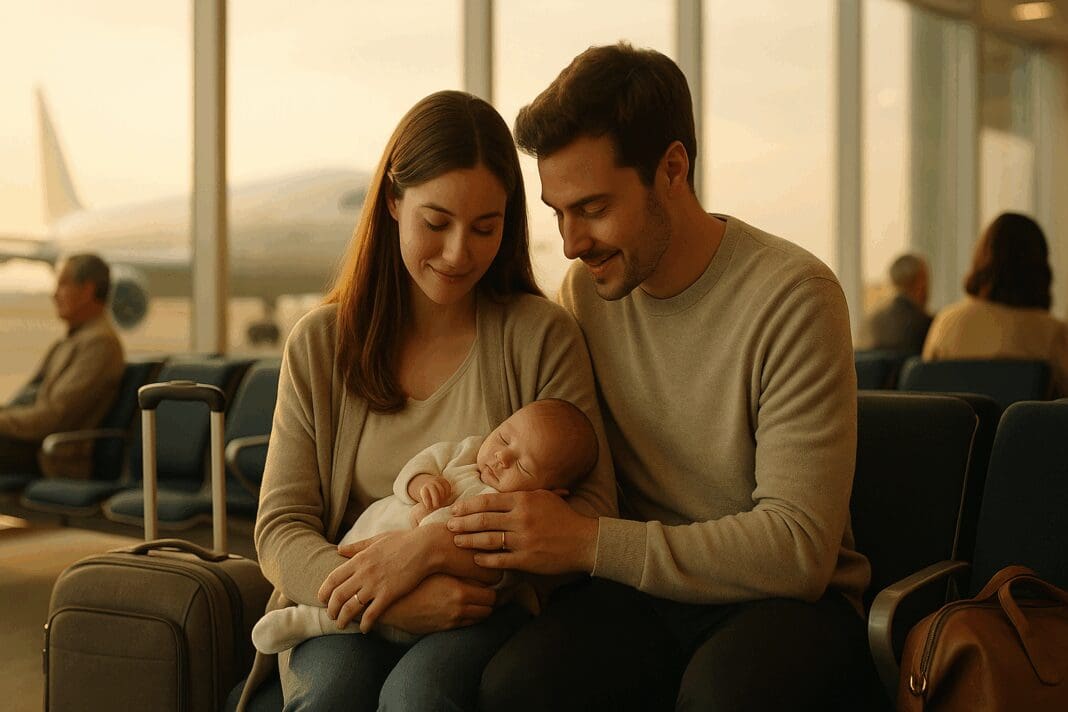Welcoming a new baby into the world is a transformative and emotionally charged experience, one that redefines priorities and routines. Yet, modern life often demands mobility, whether for family visits, relocations, or urgent responsibilities. For new parents navigating the delicate balance between nurturing their newborn and managing practical life demands, air travel becomes an inevitable question. Specifically, many parents find themselves wondering, “when is it safe to fly with a baby?” This question carries not just logistical concerns, but deep emotional weight, as the answer must reconcile a child’s developmental needs, health considerations, and the unpredictable nature of air travel. Understanding when and how to fly with an infant safely requires a nuanced, medically informed approach rooted in both scientific insight and real-world experience. This article offers that clarity and support.
You may also like: Essential Baby Care and Maternity Tips Every First Time Parent Needs to Know

Understanding the Risks of Air Travel for Infants
Newborns are particularly vulnerable during their first few months, and their unique physiology introduces specific risks when it comes to air travel. Their immune systems are still developing, making them more susceptible to infections, especially in enclosed environments like airplanes where recycled air and proximity to other passengers can increase the chances of exposure to airborne pathogens. Furthermore, changes in cabin pressure can be problematic, particularly for infants with underlying respiratory or ear issues, as they may struggle with the pressure equalization required during takeoff and landing.
Beyond medical risks, the general stress of flying—from unfamiliar environments and temperature fluctuations to noise and vibration—can be overwhelming for a newborn. Flight turbulence and in-cabin pressure changes may also aggravate colic or lead to increased irritability. All of these factors combine to make the decision to fly a multifaceted one. Thus, when considering how young can a baby fly, it is essential to weigh not only physical health but also the broader context of the baby’s developmental stage and emotional wellbeing.

How Soon Can a Newborn Fly According to Medical Guidelines?
Medical professionals generally advise against flying with a newborn within the first one to two weeks of life unless it is absolutely necessary. During this critical window, a baby is adjusting to life outside the womb, establishing feeding routines, and developing a basic immune defense. Many pediatricians recommend waiting until the baby is at least six to eight weeks old before considering non-essential air travel.
Airlines also set their own guidelines, with some allowing travel as early as 48 hours after birth, provided there is a note from a medical provider. However, just because travel is permitted doesn’t mean it is advisable. Pediatricians often caution against interpreting airline policies as medical endorsements. When evaluating how soon can a newborn fly, it is crucial to consult your child’s healthcare provider. They can assess any underlying health conditions, birth complications, or early developmental concerns that might affect flight readiness.
When Is It Safe to Fly With a Baby Who Was Born Prematurely?
The question of when is it safe to fly with a baby becomes more complex when considering premature infants. Babies born before 37 weeks often face additional health challenges, including underdeveloped lungs, weakened immune systems, and difficulty regulating body temperature. These vulnerabilities can make them particularly susceptible to the challenges of flight.
For premature babies, the consensus among neonatologists is to wait at least three months before air travel. During this period, the child should undergo follow-up assessments to ensure respiratory stability, adequate weight gain, and proper feeding. Flying prematurely can pose serious risks if the baby hasn’t reached specific milestones. Parents should also consider oxygen saturation tests at sea level and simulated cabin altitudes, especially for infants with a history of apnea or oxygen dependency. In these cases, a thorough evaluation by a pediatrician or neonatologist is not just advisable but essential.
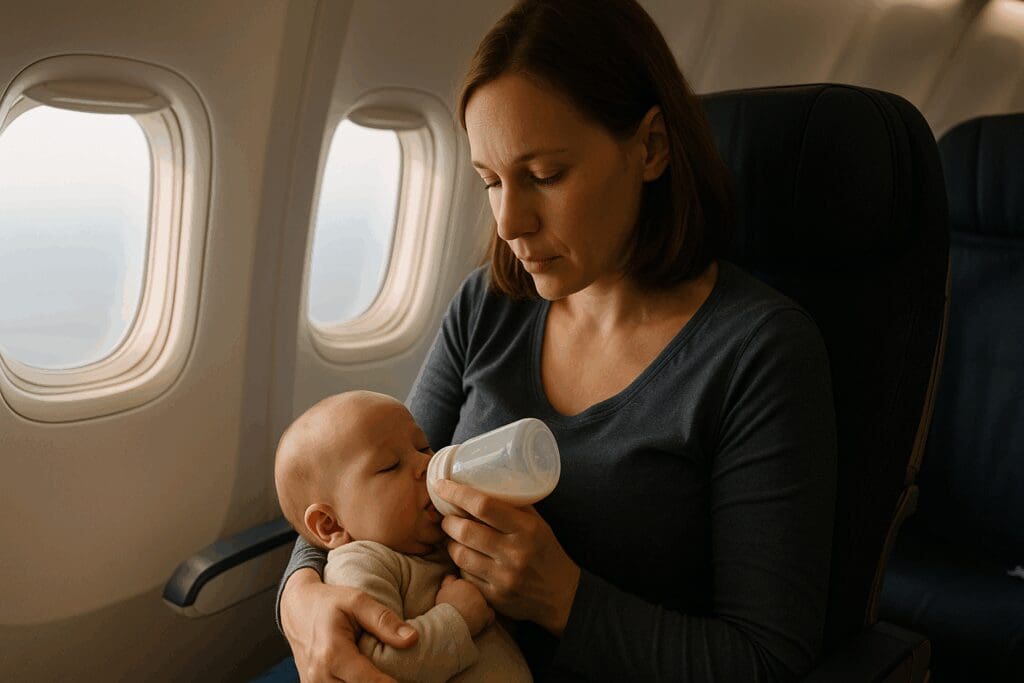
What to Expect During Takeoff and Landing
Takeoff and landing are the most physically taxing portions of a flight for infants due to rapid changes in cabin pressure. These shifts can cause discomfort or pain in the baby’s middle ear, resulting in crying or restlessness. To ease this discomfort, pediatricians often recommend feeding the baby—whether breastfeeding or bottle-feeding—during these intervals. The sucking motion helps regulate ear pressure and can provide comfort through physical closeness.
It is equally important for parents to remain calm and reassuring during these transitions. Babies are highly attuned to parental cues, and a relaxed caregiver can help reduce an infant’s stress. This is also a good time to ensure that the baby is securely fastened using FAA-approved infant restraints or held securely with an airline-approved device. Being prepared for these transitions enhances the overall travel experience and ensures safety.
When Is It Safe to Fly With a Baby? Guidelines for Full-Term Infants
The focus keyword question, “when is it safe to fly with a baby,” holds slightly different answers for full-term infants depending on health status and individual development. Generally, if the baby is born at full term (around 39 to 41 weeks gestation), has passed initial health screenings, and is feeding and growing well, air travel is considered safer from about six weeks onward.
However, there are nuances to consider. For example, if the baby has experienced jaundice, has feeding difficulties, or is slow to gain weight, travel may need to be delayed. It’s also wise to avoid flying during periods of illness, such as a cold or gastrointestinal upset, as these can be exacerbated by the stress of flying. An individual assessment by your pediatrician can help tailor recommendations, ensuring that travel plans align with the child’s medical profile.
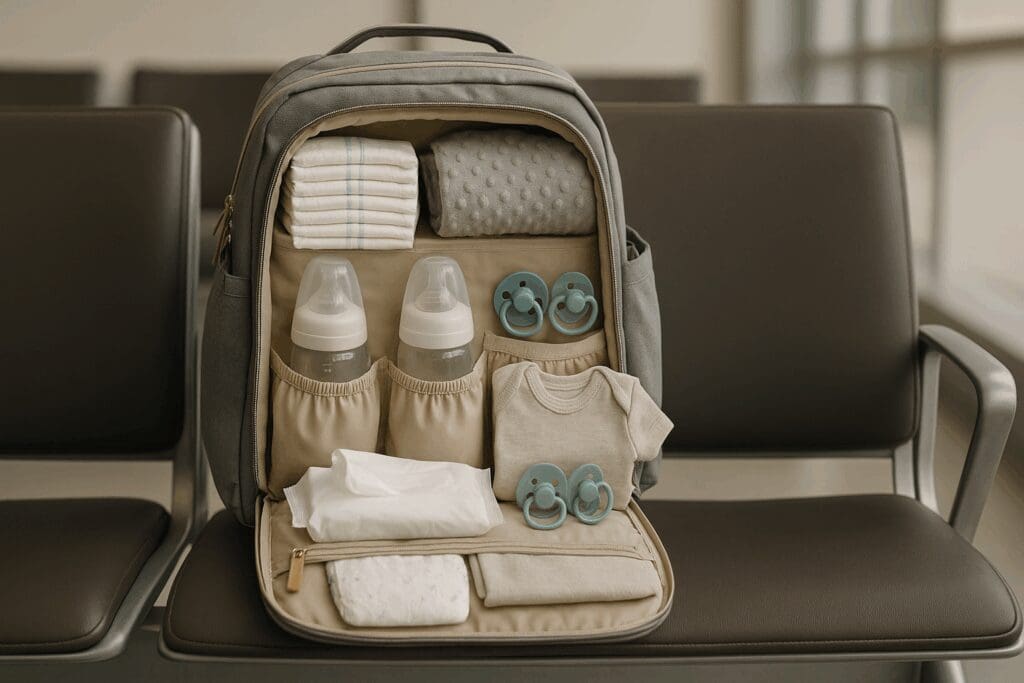
Tips for Safe and Comfortable Travel With a Newborn
Once you’ve established that your baby is medically cleared for travel, planning becomes the next critical step. First and foremost, choose flights that align with your baby’s routine. Morning flights tend to be less crowded and more likely to depart on time, which reduces the unpredictability factor. Whenever possible, book direct flights to limit exposure to different environments and minimize the stress of layovers.
Make sure to pack all essentials in an easily accessible diaper bag. This includes extra clothes, plenty of diapers, feeding supplies, and comfort items like pacifiers or small toys. Wearing your baby in a soft carrier can be invaluable for navigating airport security and boarding processes. Additionally, consider requesting a bulkhead seat or a bassinet (if the airline provides one) to offer more space and comfort.
Hydration is crucial, not just for the baby but also for the breastfeeding parent. Dry cabin air can cause dehydration, which may impact milk supply. Plan ahead for feeding by bringing pumped milk, formula, or snacks if your baby is already on solids. During the flight, monitor your baby’s cues closely, and don’t hesitate to ask flight attendants for support if needed. Being well-prepared reduces stress and promotes a smoother journey.
How Soon Can You Travel With a Newborn by Air or Car?
While much of the discussion centers on flying, many parents also wonder how soon can you travel with a newborn by car. The answer varies depending on the baby’s health and the length of the trip. Short car rides are usually safe within a few days after birth, provided that the baby is securely placed in a properly installed, rear-facing car seat. For longer journeys, it’s advisable to wait until the baby is a few weeks old to ensure feeding routines and diapering needs can be more predictably managed.
It’s also important to factor in frequent breaks. The American Academy of Pediatrics recommends limiting the time newborns spend in car seats to no more than two hours at a stretch, due to concerns about airway positioning and circulation. If the baby falls asleep in the car seat after arriving at your destination, move them to a flat, firm sleeping surface. Whether traveling by air or by road, newborns require attentive planning and accommodations to maintain their health and comfort.
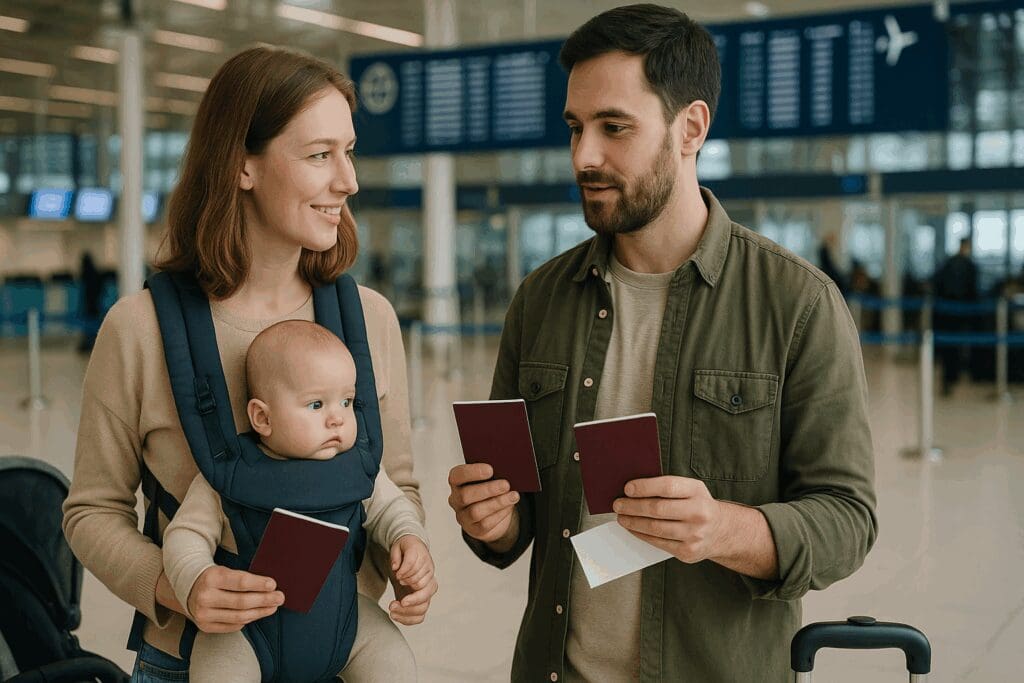
When Can You Travel With a Baby Internationally?
International travel introduces a new layer of complexity to the question of when can you travel with a baby. Long-haul flights, varying time zones, unfamiliar climates, and different health systems can pose additional risks and challenges. Ideally, international trips should be postponed until the baby is at least three to six months old and has received key vaccinations, such as the first doses of DTaP, Hib, Polio, Hepatitis B, and Rotavirus.
Furthermore, consult a travel medicine specialist if your destination has a high prevalence of diseases such as malaria, Zika, or yellow fever. In some cases, infants may not be eligible for certain vaccinations, making travel inadvisable. Also consider passport and visa logistics; all travelers, including infants, need their own valid passports. From a logistical and safety standpoint, international travel with a newborn demands extensive preparation and a heightened awareness of global health guidelines.
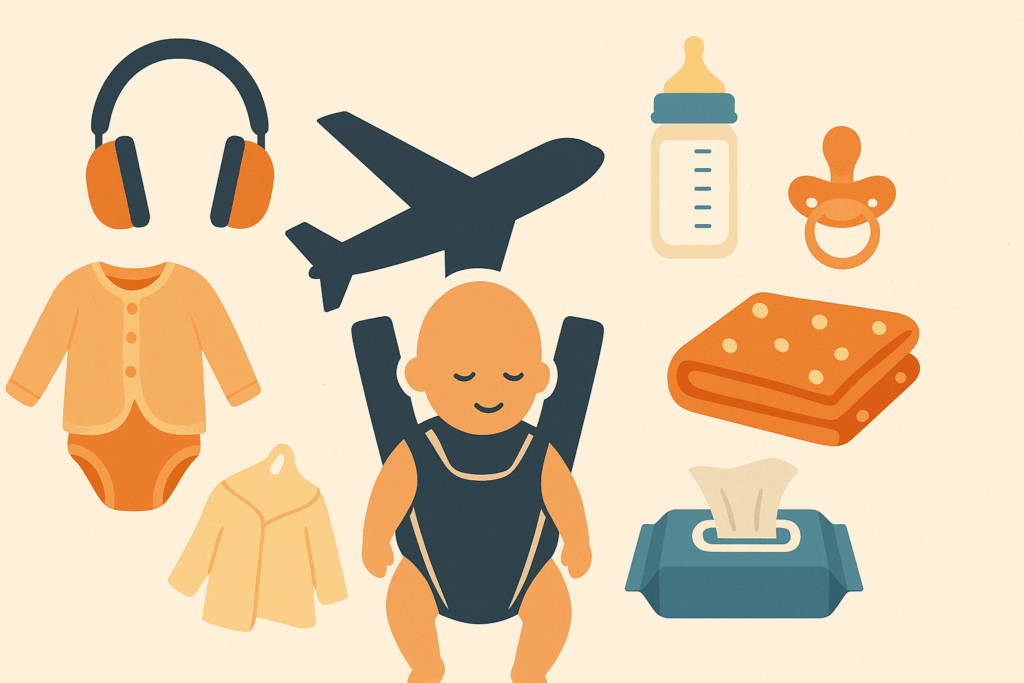
Newborns and Flying: How to Mitigate Environmental Stressors
Flying can expose newborns to environmental stressors such as dry air, temperature fluctuations, unfamiliar noises, and vibrations. These variables can affect a baby’s breathing, skin condition, and general comfort. To address dry cabin air, parents should ensure babies are adequately hydrated. For breastfed infants, feeding more frequently may help; formula-fed infants might require small amounts of additional water with pediatrician approval.
Dress the baby in breathable, layered clothing to easily adapt to cabin temperatures. Noise-canceling earmuffs designed for infants can shield sensitive ears from loud announcements or the ambient drone of the aircraft. Swaddling or using a wearable blanket can provide a sense of security, helping soothe the baby during rest periods. Also, pay attention to hygiene. Airplane tray tables and armrests are not always sanitized thoroughly, so using disposable covers or wipes can help reduce the risk of exposure to germs. Careful planning helps mitigate environmental factors, ensuring your newborn remains as comfortable as possible.
When Is It Safe to Travel With a Newborn Who Has Health Conditions?
Traveling with an infant who has health issues requires additional caution. Babies with respiratory conditions such as bronchopulmonary dysplasia, congenital heart disease, or gastrointestinal problems may need specialized care or monitoring during a flight. In some cases, supplemental oxygen or a portable apnea monitor may be recommended.
Before making any travel decisions, consult with a pediatric subspecialist familiar with your child’s condition. They may recommend additional immunizations or medications to mitigate potential risks. Parents should also obtain a detailed medical letter summarizing the child’s condition, medications, and emergency contacts, especially if traveling internationally. A travel health kit, complete with prescriptions, feeding accessories, and first aid essentials, should always accompany high-risk infants. Traveling with a baby who has health concerns is certainly feasible with proper guidance and preparation, but the margin for error is smaller, and medical advice should always guide your choices.
Flying Etiquette and Emotional Support for Parents
It’s common for new parents to feel anxious about flying with a newborn, especially due to concerns about disturbing fellow passengers. However, most travelers understand that babies cry and need attention, and those who don’t are often the exception. To foster a supportive environment, parents can take proactive steps such as greeting nearby passengers, offering earplugs, or explaining that it’s the baby’s first flight. These small gestures can go a long way in diffusing tension.
Equally important is emotional self-care. Travel with a newborn can be exhausting and emotionally taxing. Remember that perfection isn’t the goal; adaptability is. Celebrate small victories, like a quiet nap or a successful feeding. Lean on your travel partner for shared responsibilities, and don’t hesitate to ask flight staff for assistance. Parenting in transit is an act of courage, and acknowledging that truth can transform the journey from a stressor into a shared accomplishment.
Navigating Airports With a Newborn: Practical Strategies
Getting through an airport with a newborn requires strategic planning. Aim to arrive early, allowing ample time for check-in, security, and last-minute feedings or diaper changes. TSA allows parents to carry breast milk, formula, and baby food in quantities exceeding the standard 3.4-ounce limit, but these items must be declared during security screening. Bringing documentation such as a doctor’s note or birth certificate can be helpful but is not always required.
Consider investing in a lightweight travel stroller or car seat combo that meets airline size regulations and fits easily into overhead compartments or gate-check policies. Many parents also benefit from using a baby carrier through security checkpoints and while boarding. Be sure to identify nursing rooms or family restrooms in advance via airport maps. By minimizing surprises, you enhance both your baby’s comfort and your own sense of control over the journey.
When Is It Safe to Fly With a Baby During Cold and Flu Season?
Flying during peak illness seasons introduces additional considerations. Newborns are highly vulnerable to respiratory viruses like RSV and influenza, which can have serious consequences in early infancy. If travel is unavoidable, parents should take all possible precautions to shield their baby. This includes choosing flights during less crowded times, using sanitizing wipes on shared surfaces, and avoiding contact with visibly ill passengers.
Wearing a mask and encouraging fellow travelers to do the same can provide another layer of protection. For infants under six months, maternal vaccination during pregnancy can confer passive immunity against certain illnesses like flu and pertussis. If your baby is older than six months, ensure their immunizations are current. The decision to fly during cold and flu season should be made in consultation with your pediatrician, especially for high-risk infants.
FAQ: Navigating Infant Air Travel With Confidence and Clarity
When Is It Safe to Fly With a Baby Born During Cold and Flu Season?
Traveling with a newborn during the height of viral outbreaks introduces several unique challenges that extend beyond the standard considerations. While many parents assume the risks are solely about exposure to airborne viruses, one overlooked factor is the impact of seasonal allergens and fluctuating cabin temperatures on newborn respiratory health. It’s not only the presence of other passengers who may be ill that poses a threat, but also the reduced ability to isolate or create a germ-free zone during high-traffic travel periods. Pediatricians may advise delaying non-essential travel if your baby is younger than six weeks, particularly if they haven’t received protective vaccinations yet. In such cases, when is it safe to fly with a baby becomes a question influenced by both local epidemiology and your child’s individual immunity profile, rather than a fixed timeline.
How Soon Can You Travel With a Newborn on a Multi-Leg Flight?
Although a newborn might physically tolerate a short flight, multi-leg itineraries add complexity that can affect their wellbeing. These extended journeys involve multiple pressurization cycles, inconsistent feeding times, prolonged exposure to new microbes, and irregular temperature environments. When determining how soon can you travel with a newborn on such a journey, it’s vital to consider not just age but overall resilience and flexibility of their current feeding and sleep schedule. Unlike a single direct flight, layovers can disrupt routines significantly, which may lead to feeding aversion, overstimulation, or difficulty settling once you reach your destination. A good rule of thumb is to wait until at least two months old for complex travel, and even then, only if the baby is consistently feeding well and gaining weight, and if the route allows ample downtime between segments.
What Strategies Help Regulate a Newborn’s Circadian Rhythm After Travel?
Crossing time zones with a newborn may not immediately disrupt their circadian rhythm the way it does for adults, but once they reach about six to eight weeks of age, their internal clock begins to form. To minimize post-flight disruption, expose your infant to natural daylight at your destination as soon as possible. Dim the lights during your baby’s sleep times to help them distinguish between day and night, especially after long-haul flights. Maintain familiar cues such as a bedtime lullaby or swaddling to provide consistent markers of rest, regardless of the time zone. For parents asking how soon can a newborn fly without long-term schedule setbacks, the answer depends largely on your ability to maintain rhythm post-flight through consistent caregiving cues and controlled light exposure.
When Can You Travel With a Baby to High-Altitude Destinations?
Traveling to destinations above 8,000 feet introduces physiological challenges, especially for newborns whose respiratory systems are still maturing. High altitudes mean lower oxygen levels, which can lead to subtle hypoxia in infants that may go undetected without monitoring. When can you travel with a baby to such destinations depends on more than age—it requires a recent medical evaluation of oxygen saturation and cardiovascular stability. Parents should be particularly cautious with infants under three months of age or those with any history of apnea or respiratory distress. If high-altitude travel is essential, consider bringing a portable oximeter and consult with a pediatric pulmonologist before finalizing plans.
When Is It Safe to Fly With a Baby on an Overnight Flight?
Overnight flights offer the promise of peace and quiet, but they can also present distinct challenges. Newborns may be more prone to temperature regulation issues in colder cabin environments at night, and feeding logistics can become more complicated if lights are dimmed or if turbulence restricts movement. For parents weighing when is it safe to fly with a baby overnight, consider your child’s current nighttime feeding pattern and temperament. If your baby is still waking every two hours to feed and struggles with unfamiliar environments, it may be worth waiting until they’re closer to three months and have a longer stretch of consolidated sleep. Bringing sleep aids such as a sound machine or familiar blanket can help recreate the comfort of home during in-flight rest periods.
How Young Can a Baby Fly Safely With Siblings on Board?
When planning travel with older siblings, safety and stress levels for the newborn can change dramatically. The activity level, attention needs, and unpredictability of other children in the cabin may overstimulate or disrupt the newborn’s routine. In these situations, how young can a baby fly also depends on the family’s ability to allocate caregiving roles. Ideally, two caregivers should be present to divide attention, especially on longer flights. It’s helpful to prepare siblings in advance with age-appropriate discussions about gentle behavior and setting expectations for shared space. Strategic seating arrangements—such as placing the newborn and one parent in a quieter part of the plane—can also reduce cumulative stress during the flight.
What Are Some Unexpected Benefits of Flying With a Newborn?
Despite the challenges, there are surprising advantages to traveling with a baby under six months. Infants at this stage are often more portable, sleep for longer stretches, and require fewer distractions compared to older babies or toddlers. For families pondering how soon can a newborn fly without the chaos that accompanies toddler travel, early infancy can be a strategic window for smoother transitions. Additionally, many airlines offer boarding priority, extra assistance, and on-request amenities such as bassinets for newborns. The quiet bonding time during a flight—away from screens and household chores—can also provide meaningful moments of connection that are often hard to come by in daily life.
How Do International Entry Requirements Affect When You Can Travel With a Newborn?
In the context of international travel, administrative factors can influence when can you travel with a newborn far more than health considerations alone. Every infant requires a passport for international flights, and many countries have specific entry rules regarding vaccinations, visa processing, or even quarantine mandates. For example, some nations require documentation of a child’s immunization schedule or prohibit entry for unvaccinated infants during local outbreaks. It may take several weeks post-birth to gather necessary documents, which extends the timeline before travel can even be considered. Therefore, how soon can you travel with a newborn abroad depends just as much on bureaucratic processes as it does on pediatric health milestones.
How Do Cultural Practices Influence Decisions Around Newborn Travel?
Cultural norms play a significant role in shaping parents’ comfort with early infant travel. In some cultures, a newborn may be kept home for 40 days as a period of postpartum confinement and bonding, with travel during this time seen as taboo or inappropriate. In contrast, other communities may view early exposure to different environments as enriching and acceptable. This cultural lens also affects how others respond to seeing newborns in public spaces such as airports or on planes. For parents asking when is it safe to travel with a newborn, considering cultural expectations—both from their own traditions and those of their destination—can enhance both preparedness and social ease during travel. Understanding and honoring these values adds depth and intentionality to the planning process.
When Is It Safe to Fly With a Baby During Ongoing Public Health Emergencies?
In times of global health alerts or pandemics, the calculus for when is it safe to fly with a baby changes dramatically. These situations require vigilance not only for airborne illness risk but also for policy changes that can disrupt travel mid-journey, such as sudden border closures or mandatory quarantines. Babies may be at higher risk of complications from novel viruses, especially those under six months who are not yet vaccinated against common diseases. Parents should consult both pediatric infectious disease experts and travel health advisories before planning travel during such times. Choosing airlines with flexible change policies and carrying documentation of your baby\u2019s medical history may also mitigate unforeseen disruptions. In these contexts, travel with a newborn demands adaptability and heightened awareness of evolving global health conditions.
Final Thoughts: Embracing the Journey With Confidence and Care
Determining when is it safe to fly with a baby involves a deeply personal assessment shaped by medical advice, developmental readiness, and logistical planning. While the idea of traveling with a newborn may seem daunting, thoughtful preparation and professional guidance make it not only possible but often rewarding. Each infant’s needs are unique, and so too should be the approach to travel.
The answers to questions like how soon can you travel with a newborn, or when is it safe to travel with a newborn, are not one-size-fits-all. By considering health status, destination, travel logistics, and emotional readiness, parents can arrive at a decision that prioritizes both safety and comfort. Whether the journey is born out of necessity or a desire to introduce your child to the wider world, flying with a baby marks a meaningful milestone. With care, preparation, and confidence, parents can rise to meet this challenge and forge joyful memories along the way.

